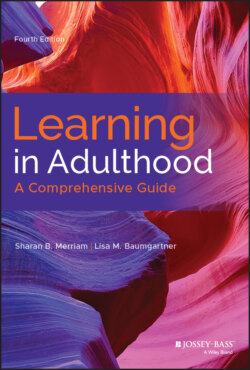Читать книгу Learning in Adulthood - Sharan B. Merriam - Страница 30
The Future of Technology in Adult and Higher Education
ОглавлениеAs is shown by the assistive technologies available to older adults, technology continues to evolve. Nanotechnology “is technology that functions at the atomic level. ‘Nano’ refers to… the width of five carbon atoms” (Picciano, 2019, p. 162). Companies are working on nanochip technology so “the whole concept of a digital computer may give way at some point to a quantum computer that operates entirely on the scale the size of atoms and smaller” (p. 162). These advances will require changes in the delivery of education (Picciano, 2019). Others argue that quantum computing may be too expensive to be practical for educational settings.
Cloud computing will be used more by universities. If course development moves from “private developers and onto computer facilities in the cloud, the ease with which faculty and students can access course material will increase tremendously and be most attractive” (Picciano, 2019, p. 164). Students may have access to cloud materials and be able to develop their own courses of study. By the 2030s, “supercloud computer service will evolve that will… be more personalized and more integrated into people's daily lives” (p. 172). It will be able to do daily activities such as starting our car and providing medical diagnoses or legal advice.
Artificial intelligence (AI) will increasingly be used in education. Faculty will be able to use artificial intelligence to know students' strengths and weaknesses. This information will help teachers improve their instruction. Georgia Tech and Penn State already use AI for teaching and advising. AI tutors can analyze students' written work and give feedback that is helpful in large courses (Adams Becker, Cummins, Davis, Freeman, Hall Giesinger, & Ananthanarayanan, 2017). At the University of Michigan, AI is being used to assist learners with disabilities. They are working on technology that helps computers know the needs of individuals who are visually impaired or lack fine motor control (Artificial Intelligence Laboratory, 2019). Picciano (2019) predicts that “general purpose AI will have much broader capabilities and will be applied in a variety of activities” (p. 165).
As mentioned earlier in the chapter, mobile devices have enhanced learning. More than half of web browsing is performed on a mobile or tablet (Adams Becker et al., 2017). Mobile apps can increase engagement within and outside class meetings. Purdue University developed an application called Hotseat where students can ask questions in real time and respond to polls or quizzes (Becker et al., 2017). “By creating ubiquitous access to educational materials, mobiles also have potential to foster learning independence and build habits for lifelong learning” (p. 40). Joint Information Systems Committee (JISC), a web-based resource for educators, helps teachers understand mobile learning and provides teachers resources that discuss mobile learning pedagogy (JISC, 2015).
Last, LMSs (learning management systems) will continue to incorporate tools such as Google Apps and iTunes so the learner experience can be more seamless (Adams Becker et al., 2017). The next shift in LMS is to move from completing “administrative tasks to deepening the act of learning” (p. 44). This means that the learning experience needs to be more personalized and adapted to the learning needs of the student. Ideally, the next generation of LMS will integrate various types of data seamlessly and use open source web apps (Becker et al., 2017). Designers may continue to “create apps that accommodate mobile challenges, such as partial user attention and interruption, or exploit technologies with novel features in an attempt to hook the learner into using the technology to complete the learning task” (Khaddage, Müller, & Flintoff, 2016, p. 23). Between the evolution of mobile apps and the ever-changing landscape of social media (e.g., Facebook, Twitter, Reddit, wikis, etc.), self-directed learners will have a multitude of resources from which to learn.
A technology that may continue to develop is virtual reality. We have seen its use for training in the workplace, and it will be applied in a variety of contexts. Individuals can virtually tour museums and cities through Internet sites such as fullscreen 360 (www.fullscreen360.com) or take virtual fieldtrips to such places as dairy farms, the Ford Motor Company, and universities. They can enter discussion boards on topics such as the opioid epidemic, or take courses such as “The Science of Well-Being” via Coursera. Learners with binocular headsets connected to a computer can immerse themselves in virtual experiences (Varnum, 2017). Libraries and museums have embraced this technology so patrons can learn more about their world, and this technology continues to improve.
In this tech-rich learning environment, learning how to learn and how to critically evaluate information remain important skills. Although technology has changed through the years, the need to understand and interpret information has not. Given the amount of information we are exposed to each day, the ability to critically evaluate information is even more important.
